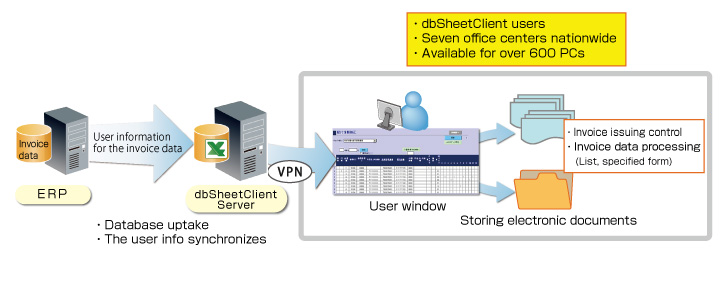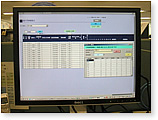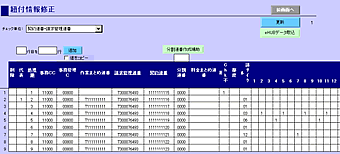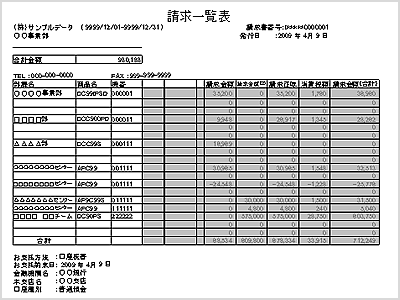System configuration Chart

System scale
- Number of registered screens: 80 screens
- Started in April 2008
- Production environment completed in July 2009
System overview

Invoice management system
Our company conducts invoice issuing related operations at 7 business centers throughout Japan (over 600 terminals).The outline of the system we recently developed by using dbSheetClient is as follows.
1.Invoice issuing information management
Work procedure (manual) management about billing, progress management, transmitting of work information
2.Creation and management of the invoice list specifications
Creating a customer based invoice list, historical management
Circumstances of the systems development

We have a main business system to support the invoice issuing operation. However, to cope with functions which are not included in this system, our operators develop necessary systems by Excel or Access. Consequently, there are a number of systems flooding the work field which have been a problem from the viewpoint of internal control.
This time we decided to develop these operations and the system as a common system of the business center.
The point that we felt was important, especially as a system requirement, was that the system was to be a Web application, and yet have a flexible operability just like using Excel. For example, it was necessary to have a mechanism to edit the invoice format such as insert/delete a line, or change the font size and column width. By making these operations easy, the productivity of operations increases.
We also didn't want to spend too much money for the mission critical system, so we looked for development tools which make it inexpensive to build a system.
We examined quite a few development tools, and finally decided to adopt Newcom’s dbSheetClient of Newcom which met all the above mentioned requirements. The main points we considered were as follows.
Problems with the current system
1.In the main business system, it was difficult to cope with the needs of each customer individually.
2.Since the operation was not standardized, the operational efficiency was low.
3.System maintenance was conducted at each working place and needed to reduce the burden.
4.It was not corresponding to the policy of enhancing internal control.
System requirements

Establish an operational system for the whole company utilizing Web technology
Technical requirements
1.It is able to work together with the main business system (database, user authentication)
2.It is easy to input/edit data with a large number of cases
3.It is easy to edit print forms
4.In-house development is possible
Reasons we adopted dbSheetClient
(1)Easy to edit data with large number of cases
We knew it would be very stressful to edit them by the browser method. →Excel interface kept possible for the first time.
(2)Flexibility of print forms
We need flexibility of creating forms to meet customers' needs. →By using Excel sheets for making templates, free formatting and printing were made possible without extra print software.
(3)In-house development is possible
A development tool is available for non-specialists.
(4)Development man-hours can be kept to a minimum
By using Excel as an interface, we thought it would be easy to develop various views.
Effect from installation

We needed to realize various functions in various forms, and with the help of Newcom engineers to add functions in dbSheetClient, we realized a standard operation system equipped with all the functions we expected to have.
Though it is a Web application system, it maintains the easy operability of conventional Excel and Access.
Thus, the system is completed with familiar operability and the operators are very happy. Usually, our company outsources the development of the operation system to outside vendors. This time, however, we made an in-house development, which reduced the development cost, improved maintenance/improvement speed, and enabled us to cope with the needs of operators promptly.
Sample screen
- Input form just like Excel window

- An invoice list where you can edit the output layout freely



